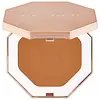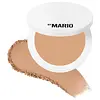What's inside
What's inside
 Key Ingredients
Key Ingredients

 Benefits
Benefits

 Concerns
Concerns

 Ingredients Side-by-side
Ingredients Side-by-side

Synthetic Fluorphlogopite
Talc
AbrasiveMagnesium Myristate
Hdi/Trimethylol Hexyllactone Crosspolymer
Mica
Cosmetic ColorantPolymethyl Methacrylate
Dimethicone
EmollientIsodecyl Neopentanoate
EmollientSilica
AbrasiveTrimethylsiloxysilicate
EmollientTriethoxycaprylylsilane
Polypropylsilsesquioxane
Diisostearyl Malate
EmollientCaprylyl Glycol
EmollientDimethiconol
EmollientPhenoxyethanol
PreservativeOctyldodecyl Stearoyl Stearate
EmollientHexylene Glycol
EmulsifyingLauroyl Lysine
Skin ConditioningTocopheryl Acetate
AntioxidantTocopherol
AntioxidantWater
Skin ConditioningMaltodextrin
AbsorbentCarica Papaya Fruit Extract
Skin ConditioningMangifera Indica Fruit Extract
Skin ConditioningCalcium Sodium Borosilicate
Calcium Aluminum Borosilicate
Xanthan Gum
EmulsifyingEthylhexylglycerin
Skin ConditioningSorbic Acid
PreservativeTin Oxide
AbrasiveCI 77288
Cosmetic ColorantIron Oxides
CI 77742
Cosmetic ColorantCI 77891
Cosmetic ColorantSynthetic Fluorphlogopite, Talc, Magnesium Myristate, Hdi/Trimethylol Hexyllactone Crosspolymer, Mica, Polymethyl Methacrylate, Dimethicone, Isodecyl Neopentanoate, Silica, Trimethylsiloxysilicate, Triethoxycaprylylsilane, Polypropylsilsesquioxane, Diisostearyl Malate, Caprylyl Glycol, Dimethiconol, Phenoxyethanol, Octyldodecyl Stearoyl Stearate, Hexylene Glycol, Lauroyl Lysine, Tocopheryl Acetate, Tocopherol, Water, Maltodextrin, Carica Papaya Fruit Extract, Mangifera Indica Fruit Extract, Calcium Sodium Borosilicate, Calcium Aluminum Borosilicate, Xanthan Gum, Ethylhexylglycerin, Sorbic Acid, Tin Oxide, CI 77288, Iron Oxides, CI 77742, CI 77891
Synthetic Fluorphlogopite
Mica
Cosmetic ColorantMagnesium Myristate
Lauroyl Lysine
Skin ConditioningDimethicone
EmollientCalcium Sodium Borosilicate
Silica
AbrasiveIsodecyl Neopentanoate
EmollientTrimethylsiloxysilicate
EmollientSodium Hyaluronate
HumectantPolypropylsilsesquioxane
Caprylyl Glycol
EmollientDiisostearyl Malate
EmollientDimethiconol
EmollientPhenoxyethanol
PreservativeHexylene Glycol
EmulsifyingCaprylic/Capric Triglyceride
MaskingPolyhydroxystearic Acid
EmulsifyingTriethoxycaprylylsilane
Isostearic Acid
CleansingLecithin
EmollientPolyglyceryl-3 Polyricinoleate
EmulsifyingCI 77491
Cosmetic ColorantCI 77492
Cosmetic ColorantCI 77499
Cosmetic ColorantCI 77742
Cosmetic ColorantSynthetic Fluorphlogopite, Mica, Magnesium Myristate, Lauroyl Lysine, Dimethicone, Calcium Sodium Borosilicate, Silica, Isodecyl Neopentanoate, Trimethylsiloxysilicate, Sodium Hyaluronate, Polypropylsilsesquioxane, Caprylyl Glycol, Diisostearyl Malate, Dimethiconol, Phenoxyethanol, Hexylene Glycol, Caprylic/Capric Triglyceride, Polyhydroxystearic Acid, Triethoxycaprylylsilane, Isostearic Acid, Lecithin, Polyglyceryl-3 Polyricinoleate, CI 77491, CI 77492, CI 77499, CI 77742
 Reviews
Reviews

Ingredients Explained
These ingredients are found in both products.
Ingredients higher up in an ingredient list are typically present in a larger amount.
Calcium Sodium Borosilicate is a bulking agent. It is considered a borosilicate glass; it is composed of powder or flakes of calcium and sodium borosilicates.
This ingredient is used to add volume, shine, and color to products. You'll most likely find this ingredient in makeup products.
According to in-vivo and ex-vivo studies done by a manufacturer, this ingredient works well with UV filters:
Learn more about Calcium Sodium BorosilicateCaprylyl Glycol is a humectant and emollient, meaning it attracts and preserves moisture.
It is a common ingredient in many products, especially those designed to hydrate skin. The primary benefits are retaining moisture, skin softening, and promoting a healthy skin barrier.
Though Caprylyl Glycol is an alcohol derived from fatty acids, it is not the kind that can dry out skin.
This ingredient is also used as a preservative to extend the life of products. It has slight antimicrobial properties.
Learn more about Caprylyl GlycolThis ingredient is used to add a violet color to cosmetics.
It is created by reacting phosphoric acid, ammonium dihydrogen orthophosphate, and manganese dioxide.
Diisostearyl Malate is an emollient and most often used in lip products. It comes from isostearyl alcohol, a fatty acid, and malic acid, an AHA.
As an emollient, Diisostearyl Malate helps create a thin film on your skin to trap moisture in. This helps keep your skin soft and smooth.
Dimethicone is a type of synthetic silicone created from natural materials such as quartz.
What it does:
Dimethicone comes in different viscosities:
Depending on the viscosity, dimethicone has different properties.
Ingredients lists don't always show which type is used, so we recommend reaching out to the brand if you have questions about the viscosity.
This ingredient is unlikely to cause irritation because it does not get absorbed into skin. However, people with silicone allergies should be careful about using this ingredient.
Note: Dimethicone may contribute to pilling. This is because it is not oil or water soluble, so pilling may occur when layered with products. When mixed with heavy oils in a formula, the outcome is also quite greasy.
Learn more about DimethiconeDimethiconol is a silicone that resembles the popular dimethicone. Like other silicones, it is an emollient. Emollients create a thin film on skin to prevent moisture from escaping.
This ingredient helps to create a silky texture and improve spreadability. Due to its high molecular weight and thickness, it is often combined with cyclopentasiloxane.
Hexylene Glycol is a surfactant. Glycols are a class of alcohols. Hexylene Glycol is a surfactant and emulsifier.
As a surfactant, Hexylene Glycol helps gather dirt and oil on your skin to be washed away.
As an emulsifier, Hexylene Glycol helps keep water and oil together. This prevents them from separating in a product. Hexylene Glycol also thins out the texture of a product by lessening viscosity.
Hexylene Glycol has a small molecular weight.
Learn more about Hexylene GlycolWe don't have a description for Isodecyl Neopentanoate yet.
This ingredient comes from a fatty acid (lauric acid) and amino acid (lysine). It is used to add a silky feel to cosmetics.
According to a manufacturer, its fatty acid base leaves a silky feeling on the skin. It also has emollient properties because of this. Emollients help soften skin by preventing water from evaporating.
Lauroyl lysine is barely soluble in water.
Learn more about Lauroyl LysineWe don't have a description for Magnesium Myristate yet.
Mica is a naturally occurring mineral used to add shimmer and color in cosmetics. It can also help improve the texture of a product or give it an opaque, white/silver color.
Serecite is the name for very fine but ragged grains of mica.
This ingredient is often coated with metal oxides like titanium dioxide. Trace amounts of heavy metals may be found in mica, but these metals are not harmful in our personal products.
Mica has been used since prehistoric times throughout the world. Ancient Egyptian, Indian, Greek, Roman, Aztec, and Chinese civilizations have used mica.
Learn more about MicaPhenoxyethanol is a preservative that has germicide, antimicrobial, and aromatic properties. Studies show that phenoxyethanol can prevent microbial growth. By itself, it has a scent that is similar to that of a rose.
It's often used in formulations along with Caprylyl Glycol to preserve the shelf life of products.
Polypropylsilsesquioxane is a synthetic silicone resin used to create a flexible, water-resistant layer on the skin or hair.
This helps improve the wear and transfer resistance in products like foundations, sunscreens, and colored makeup without feeling greasy.
Silica, also known as silicon dioxide, is a naturally occurring mineral. It is used as a fine, spherical, and porous powder in cosmetics.
Though it has exfoliant properties, the function of silica varies depending on the product.
The unique structure of silica enhances the spreadability and adds smoothness, making it a great texture enhancer.
It is also used as an active carrier, emulsifier, and mattifier due to its ability to absorb excess oil.
In some products, tiny microneedles called spicules are made from silica or hydrolyzed sponge. When you rub them in, they lightly polish away dead skin layers and enhance the penetration of active ingredients.
Learn more about SilicaSynthetic Fluorphlogopite is the synthethic version of mica. It consists of fluorine, aluminum and silicate.
Synthetic Fluorphlogopite is used to add volume to products.
It is considered non-irritating on the skin.
Learn more about Synthetic FluorphlogopiteTriethoxycaprylylsilane is a silicone used to bind and stabilize ingredients.
As an emulsifier, it helps prevent ingredients from separating. This can help elongate the shelf life of products.
Triethoxycaprylylsilane is often used to coat mineral sunscreens ingredients to help give a better feel. It also helps reduce oxidative stress in sunscreens.
Learn more about TriethoxycaprylylsilaneThis silicone is an emollient. Emollients create a thin film on the skin to prevent moisture from escaping.
It is not soluble in water and helps increase water-resistance in products.
According to a manufacturer, it can blend seamlessly with silicone oils, such as Cyclopentasiloxane.
Learn more about Trimethylsiloxysilicate